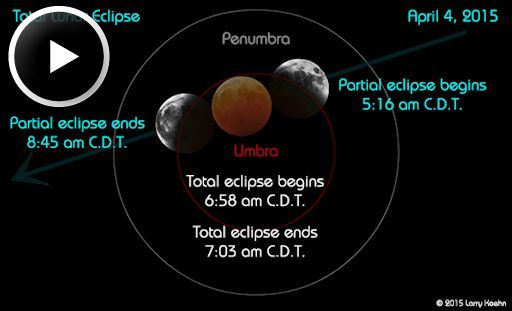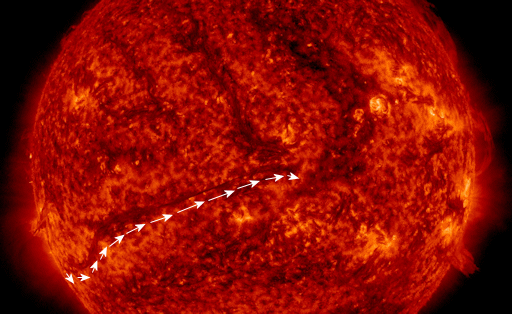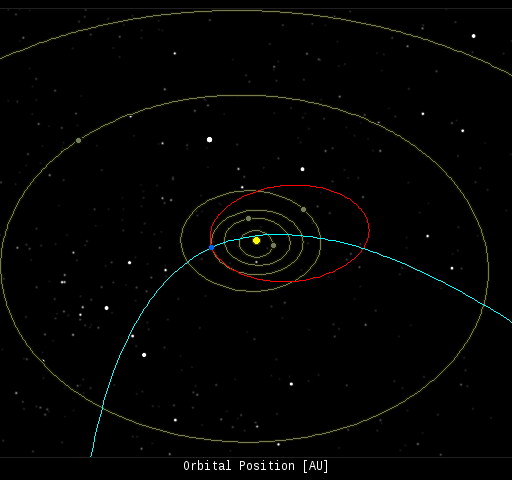Come to Tromsø and share Marianne's passion for rural photography: Chasethelighttours.co.uk invites you to experience "Heaven on Earth" with an aurora, fjord, fishing, whale watching, photography or sightseeing tour. | | |
QUIET SUN: With no sunspots actively flaring, the sun's X-ray output has flatlined. Solar activity is very low. NOAA forecasters estimate a scant 5% chance of X-class flares today. Solar flare alerts: text, voice
TOTAL LUNAR ECLIPSE: It's déjà vu all over again. For the third time in less than a year, sky watchers in the United States can see a total eclipse of the Moon. The action begins Saturday morning, April 4th, at 3:16 a.m. Pacific Daylight Time when the edge of the Moon first enters the amber core of Earth’s shadow. For the next hour and 45 minutes, Earth's shadow will move across the lunar disk, ultimately swallowing the entire Moon at 4:58 AM PDT. A movie from ShadowAndSubstance.com previews the transformation:

"Totality" is when the Moon is fully inside Earth's shadow. Some total eclipses last for more than an hour. In this case, however, totality spans just 4 minutes and 43 seconds—a result of the fact that the Moon is skimming the outskirts of Earth's shadow rather than passing centrally through it. The brevity of the eclipse highlights the importance of watching the clock: Be outside no later than 4:58 AM PDT to witness the red Moon.
Why red?
A quick trip to the Moon provides the answer: Imagine yourself standing on a dusty lunar plain looking up at the sky. Overhead hangs Earth, nightside down, completely hiding the sun behind it. The eclipse is underway.
You might expect Earth seen in this way to be utterly dark, but it's not. The rim of the planet looks like it is on fire. As you scan your eye around Earth's circumference, you're seeing every sunrise and every sunset in the world, all of them, all at once. This incredible light beams into the heart of Earth's shadow, filling it with a coppery glow and transforming the Moon into a great red orb when viewed from Earth.
The eclipse will be visible, to some degree, across the entire Pacific side of our planet. A map of the eclipse zone shows where to look.
Realtime Eclipse Photo Gallery
LONG SOLAR FILAMENT: Most solar flares come from sunspots. The next big explosion, however, could come from a different source: A huge magnetic filament is hanging precariously over the surface of the sun. NASA's Solar Dynamics Observatory (SDO) photographed the structure on April 2nd:

From end to end, the plasma-loaded filament stretches 700,000 km, almost twice the distance from Earth to the Moon. The dimensions of the structure make it an easy target not only for space telescopes like SDO, but also for backyard solar telescopes on Earth.
If the filament becomes unstable and erupts, it could hurl parts of itself into space. Pieces of the filament falling back to the solar surface would explode upon impact, creating one or more Hyder flares. Amateur astronomers are encouraged to monitor the structure as it turns toward Earth. A photogenic explosion might be in the offing.
Realtime Space Weather Photo Gallery
Realtime Aurora Photo Gallery
Realtime Comet Photo Gallery
Every night, a network of NASA all-sky cameras scans the skies above the United States for meteoritic fireballs. Automated software maintained by NASA's Meteoroid Environment Office calculates their orbits, velocity, penetration depth in Earth's atmosphere and many other characteristics. Daily results are presented here on Spaceweather.com.
On Apr. 2, 2015, the network reported 4 fireballs.
(4 sporadics)

In this diagram of the inner solar system, all of the fireball orbits intersect at a single point--Earth. The orbits are color-coded by velocity, from slow (red) to fast (blue). [Larger image] [movies]
Potentially Hazardous Asteroids (
PHAs) are space rocks larger than approximately 100m that can come closer to Earth than 0.05 AU. None of the known PHAs is on a collision course with our planet, although astronomers are finding
new ones all the time.
On April 2, 2015 there were potentially hazardous asteroids.
Notes: LD means "Lunar Distance." 1 LD = 384,401 km, the distance between Earth and the Moon. 1 LD also equals 0.00256 AU. MAG is the visual magnitude of the asteroid on the date of closest approach. | | The official U.S. government space weather bureau |
| | The first place to look for information about sundogs, pillars, rainbows and related phenomena. |
| | Researchers call it a "Hubble for the sun." SDO is the most advanced solar observatory ever. |
| | 3D views of the sun from NASA's Solar and Terrestrial Relations Observatory |
| | Realtime and archival images of the Sun from SOHO. |
| | from the NOAA Space Environment Center |
| | the underlying science of space weather |

